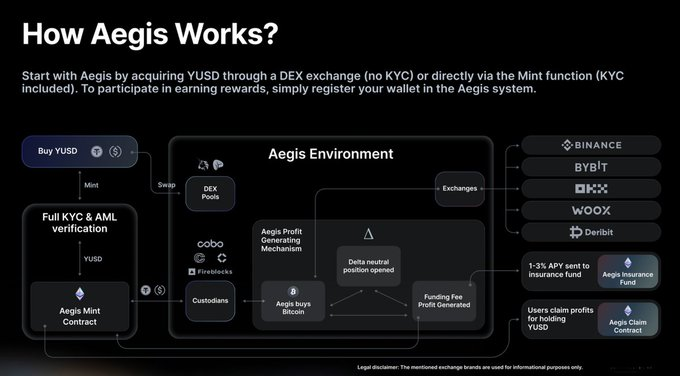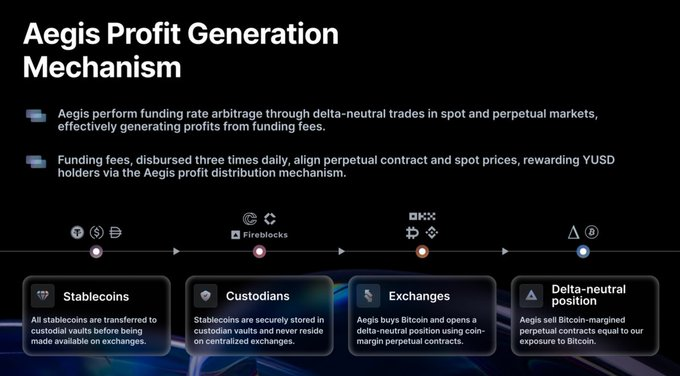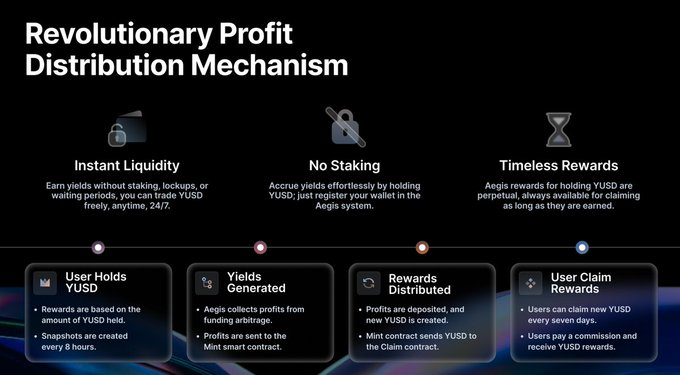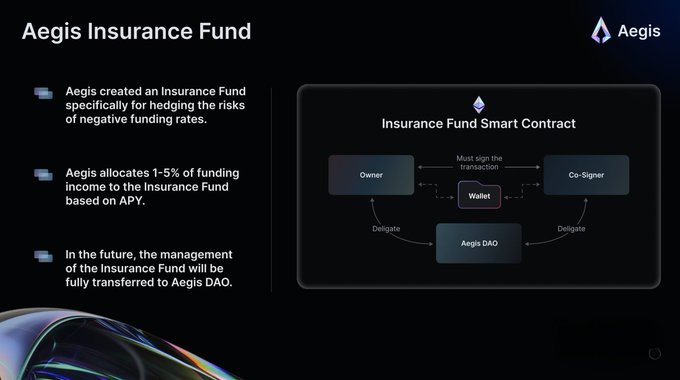Author: Stacy Muur
Compiled by: Tim, PANews
We have seen fiat-backed stablecoins and cryptocurrency-collateralized stablecoins. However, Aegis has a different approach: a Bitcoin-backed stablecoin.
Below are the bold aspects of its design and the reasons it may succeed.

The vast majority of stablecoins today rely on a centralized system, which is what Bitcoin was designed to avoid:
- Fiat custody
- Bank settlement
- Regulatory constraints
Aegis takes a different strategy, choosing to build its system around Bitcoin rather than banks.
Aegis names its stablecoin YUSD:
- Pegged to the price of 1 USD
- Supported by Bitcoin collateral
- Maintained stable through short perpetual contracts
No oracles, no fiat reserves, no third-party intermediaries

YUSD is only minted when stablecoins like USDT, USDC, or DAI are deposited into the Aegis Mint smart contract.
Once verified, YUSD is generated, and the corresponding collateral is transferred to a secure custody vault.
No off-chain minting switches, no human intervention, everything is controlled solely by smart contract logic.

So, how does Aegis achieve end-to-end operation?
- You can use funds to mint or exchange (on-chain or decentralized exchanges) to obtain YUSD
- Aegis uses these funds to purchase BTC
- It hedges price volatility risk by opening short perpetual contracts
- The short position earns funding fee income
- Revenue distribution: part injected into the insurance pool, part distributed to YUSD holders
This is the cyclical mechanism of YUSD.

But where do these profits come from?
When Aegis shorts Bitcoin perpetual contracts, it profits from the funding fees paid by traders who are bullish.
As long as there is demand to go long, these fees will be charged three times a day.
This is not staking, nor is it inflation.
This is the conversion of counterparty pressure into profit.

Aegis will not require you to do anything extra.
Hold YUSD → Aegis earns fees → Snapshot records shares → Rewards generated → Claim through the APP
Look, the profits come effortlessly.

The construction of Aegis aims to ensure safety and reliability, independently avoiding centralized risks and common single points of failure:
- No fiat currency support
- No USDC reserves
- No reliance on oracles
Only Bitcoin, collateral hedging processing, off-chain holding, real-time monitoring.
No revenue model is perfect, especially one linked to funding rates. So, what happens if the funding rate turns negative?
Aegis has established an insurance fund for this.
- 1-5% of the revenue will be transferred to the insurance fund
- This fund will be activated when the funding rate turns negative and shorting costs increase
- Managed by a multi-signature smart contract
- Control will later be transferred to the Aegis DAO

Aegis seems to place great emphasis on transparency:
- Custodial reserves are verifiable
- Exchange positions are public
- Read-only API publicly shows system status
You don’t have to guess its internal operating logic, but you can observe the results in real-time.

The insurance fund is responsible for managing risks, while the Aegis points system drives growth. Users can earn points daily through the following methods:
- Holding YUSD (15 points per $1 daily)
- Providing liquidity (30 points per $1 daily, 2x bonus)
- Borrowing through Euler (45 points daily, 3x bonus)
- Completing social tasks (50 points per task, 5x bonus)
The product and service are now fully launched on Ethereum and BNB Chain.

In Season 1, all point earnings will receive a 50% bonus reward, allowing early users to share a higher proportion of AEG token rewards.
Excess rewards: Euler integration unlocks a cyclical strategy—deposit YUSD → earn points → borrow stablecoins → repeat this process.
This maximizes earnings and multiplies points.
Points are not just numbers. Every week, 0.2% of the total AEG supply will be distributed based on your points share.
No need to worry about airdrop delays or guess distribution rules.
Transparent and public, everything proceeds as planned and is directly linked to protocol usage.
Aegis is an early project aimed at building a stablecoin that does not rely on fiat, oracles, or permissioned collateral.
It remains uncertain whether this model will still be effective in turbulent markets or if it can scale in real-world use cases.
But it is one of the clearest experiments in Bitcoin-based monetary design to date.
免责声明:本文章仅代表作者个人观点,不代表本平台的立场和观点。本文章仅供信息分享,不构成对任何人的任何投资建议。用户与作者之间的任何争议,与本平台无关。如网页中刊载的文章或图片涉及侵权,请提供相关的权利证明和身份证明发送邮件到support@aicoin.com,本平台相关工作人员将会进行核查。



